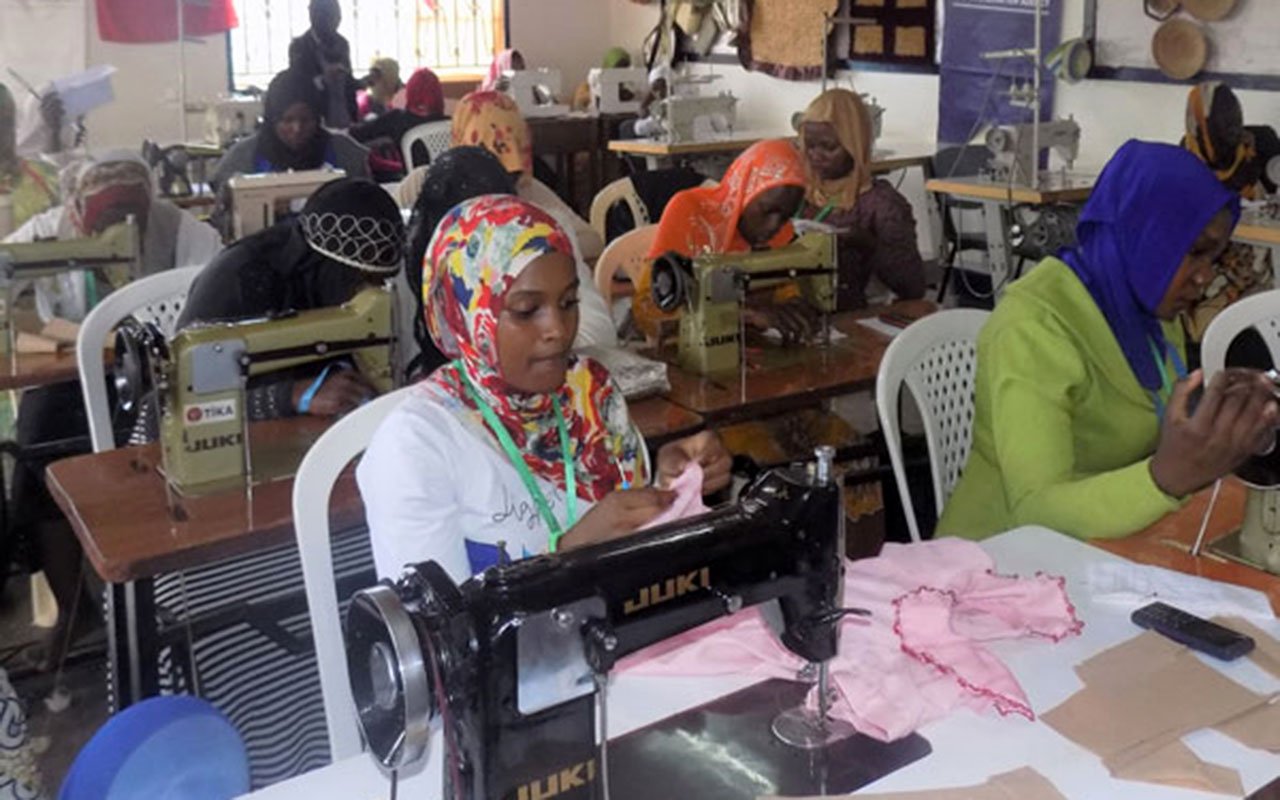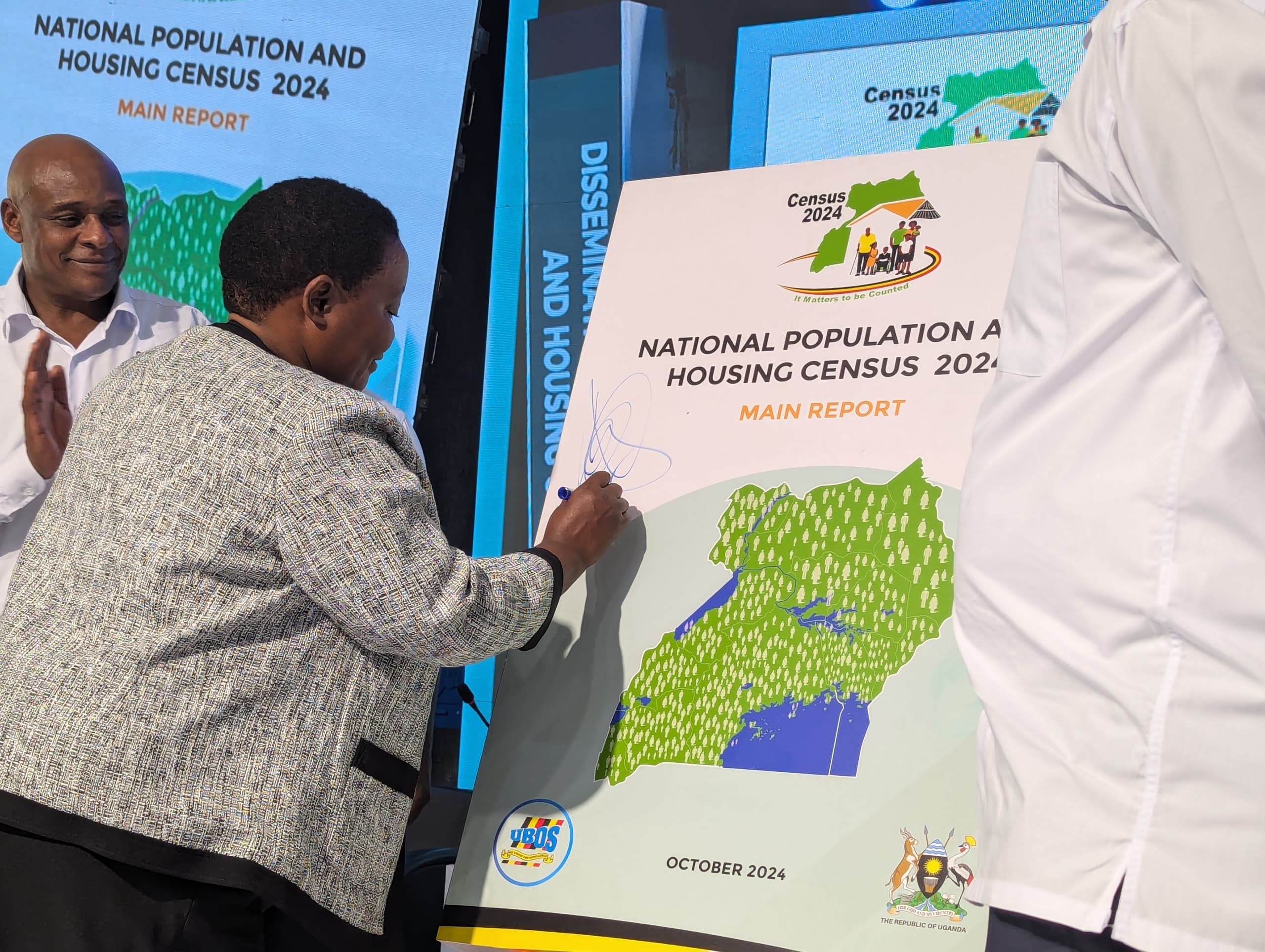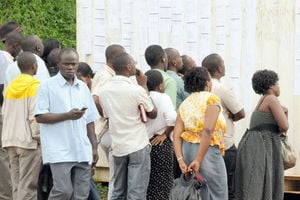
Women learn tailoring. Uganda’s young population grapples with high unemployment due to a lack of jobs meant to match its growth rate. PHOTO/FILE
Bukedi, Lango, Busoga, and Karamoja sub-regions have the highest percentage of the youth population not in Employment, Education, or Training (NEET), while Kigezi and Ankole have the lowest percentage, indicating disparities in access to public/social services and job opportunities.
This information is contained in the National Population and Household Census main report released by the Uganda Bureau of Statistics (Ubos) on Thursday last week in Kampala.
In the report, Bukedi, Lango, Busoga, and Karamoja had youth NEET rates of between 60 and 62 percent compared to Kigezi and Ankole which had the lowest rate of 39 percent. West Nile, Elgon, Teso, and Acholi had youth NEET of between 50 and 59 percent while Bunyoro, Tooro, and Buganda ranked at 40 to 49 percent.
The NEET indicator, according to information from the United Nations, is an important concept that captures a broad array of vulnerabilities among youth –touching on issues of “early school leaving, unemployment, and labour market discouragement.”
The Ubos report also shows that northern and eastern regions performed poorly in most of the socio-economic indicators such as education and access to social services when compared to the central and western parts of the country, raising questions about the effectiveness of the government’s strategies to ensure equitable development.
In general unemployment, among both youth and adults, Bukedi and West Nile sub-regions had the highest unemployment rate of around 19 percent while it was at eight percent in the Kigezi and Ankole sub-regions, indicating disparities in access to job opportunities. The national unemployment rate increased from 9.5 percent in 2013 to 13 percent in 2024.
While commenting on the Ubos report, Mr Joseph Enyimu, the acting commissioner for Economic Development, Policy, and Research Department of Finance Ministry, said the new data has provided them with a rich resource for public investment management.
He noted that the government and development partners should use the available data and determine the drivers of disparities in socioeconomic indicators and address them.
“There are issues to do with how we target public services, the ratios about how many schools we have and the rest have a lot to do with reducing inequality but also ensuring that we achieve the minimum service delivery standards that the government has set out for itself,” he said.
“Taking advantage of the digital infrastructure and connectivity that we have established, will lower the transaction cost for citizens to access public services but also when there is better access to public services then you are enhancing the savings of households. And they are able to mobilise those savings and deploy them into the kind of investments that would lessen the burden on government like on aging population,” he added.
The Ubos figures indicate that access to electricity, an important factor in production and productivity, is very low in some of the regions with high youth NEET and high unemployment rates.
The proportion of households using electricity for lighting in Karamoja and Lango is between two and five percent, which is very low compared to 54 percent in Buganda and 20 percent in Ankole.
The acting commissioner believes issues in land ownership and risks associated with private investment could be contributing to the variations in employment situation.
“What is the kind of risk to private investors? Key among these are drought, pest and diseases, and crime. These compromise the return on private investment and this means government should continue to de-risk the economy so that private individuals can have incentives to invest and get higher returns but also we can mobilise more foreign direct investment,” Mr Enyimu argued.
“The share of individuals that reported to be land owners and reported have registered land, is about 30 percent from 20 percent but in the Buganda region it is about 60 percent but in the Greater North -West Nile, Acholi, and Karamoja, it is between three and five percent,” he continued.
“So, to attract the private investment, required to deliver jobs and employment opportunities, we need to address ourselves to this issue of security of tenure. If you look at agriculture, commodities that have higher returns such as coffee, require 20 to 30 years and you are not going to get into such investment unless the security of tenure is there. We need to collectively build on the investment we have made in land administration,” he added.
Dr Jotham Musinguzi, the director general of the National Population Council, pointed out the gap in the skilling of young people as an area that needs to be fixed to increase employability globally.
“Right now you need to focus your investment in areas that are going to make a difference. Demographic dividend, the young children that are coming up, you have a huge population of young people. They are going to need jobs, education, and services. This should be planned for,” he said.
“We also need to address adolescent pregnancy and early marriage because this affects their quality of life and the quality of life of children because these adolescents can’t get good jobs to take care of themselves and their children [since they have low education attainment],” he observed.
Lango, Bunyoro, Teso, and Bukedi have childbearing rates among adolescents of eight percent and above which is higher than the four percent in Kigezi and Ankole sub-regions.
Dr Musinguzi warned that failure to address the issue of skilling and education of young people would increase crime rates in urbanised places like Kampala, affecting investments and habitation.
“The Ministry of Finance, look at the young people, focus on them. Make sure they get a good education –quality education so that they are competitive on the global platform, make sure you get them employment, they save and they become the engine of growth in the economy. Without doing this, you will see these people becoming problems on the streets of Kampala,” he said.
Prof Ibrahim Okumu from the Makerere University School of Economics also emphasized that few people are enrolling in post-secondary education, a factor he said affects the employability of young people. He called for addressing factors contributing to school dropout in some regions.
“There is a supply of pupils that could be enrolled into primary education, there is a supply of students that can enroll into high school education and those who can enroll into university education. There is a significant proportion of Ugandans that need to pick up skills,” he said.
“Within the education system, all we need to ask ourselves is: how can we enhance education service provision? There is universal primary education but the constraints that contribute to school dropout. This will mean we have those above the age of 18 but lacking the skills to participate in production space,” he added.
Available studies in the country link school drop rates to poverty, long distances to schools, lack of facilities and sanitary towels, and unplanned pregnancies as reasons for high school dropout rates.
The recent World Bank report for 2023 indicates that poverty is highest in the eastern region at 41.7 percent, followed by the northern region (39.9 percent), western (26.6 percent), and Buganda (15 percent).
Another report released last year by the Equal Opportunities Commission (EOC) also showed disparities in employment with Western and Central regions taking the biggest share of top government jobs in the country, at 40 percent and 26 percent, respectively, while northern and eastern regions were at somewhere between 12-20 percent.
“Vulnerable individuals often face challenges in accessing stable and well-paying employment opportunities. They may be employed in the informal sector with low job security, inadequate benefits, and lower wages,” the EOC report reads.
“Lack of skills, education, and training can also limit their prospects for upward mobility and income growth. Unemployment remains a big challenge, especially among the youth, women, and Persons with Disabilities,” EOC stated further.
In the Ubos report, post-secondary education attainment was very low in sub-regions with high NEET and high unemployment. Karamoja, Busoga, Bunyoro, Bukedi, West Nile, and Lango had the lowest post-secondary education attainment at 2.8- 4.7 percent, while Tooro, Teso, Acholi, and Elgon were ranked between 5-6 percent. Kigezi, Ankole, and Buganda had the best ranking of between 7.4-12 percent.
Summary of findinds
Youth Not in Employment, Education, or Training (NEET)
Bukedi 62.6%
West Nile 59.8%
Busoga 60.9%
Elgon 53.5%
Karamoja 60.9%
Buganda 41.5%
Tooro 49.3%
Teso 58.1%
Lango 62.3%
Acholi 58.4%
Bunyoro 48.3%
Kigezi 39.4%
Ankole 39.8%
Unemployment rate (14-64 years)
Bukedi 18.9%
West Nile 18.8%
Busoga 18.2%
Elgon 16.9%
Karamoja 14.7%
Buganda 11.9%
Tooro 11.9%
Teso 11.9%
Lango 11.8%
Acholi 11.7%
Bunyoro 9.8%
Kigezi 8.3%
Ankole 8.2%
Education attainment (post-secondary)
Bukedi 4.4%
West Nile 4.1%
Busoga 4.2%
Elgon 6.1%
Karamoja 2.8%
Buganda 12%
Tooro 5.1%
Teso 5.5%
Lango 4.7%
Acholi 6.2%
Bunyoro 4.3%
Kigezi 7.4%
Ankole 8.2%
The proportion of households using electricity for lighting (access to power/public services)
Bukedi 11.7%
West Nile 4.2%
Busoga 19.6%
Elgon 12.8%
Karamoja 2.2%
Buganda 54.2%
Tooro 15.3%
Teso 5.2%
Lango 5.2%
Acholi 7.2%
Bunyoro 10.4%
Kigezi 13.1%
Ankole 20.7%



